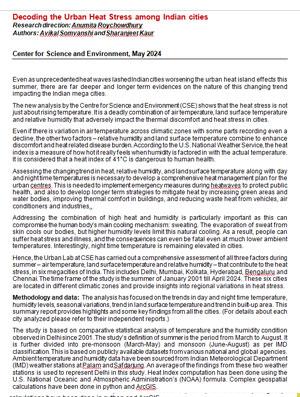CSE study tracks heat wave unravelling dangerous trends in Indian cities
· CSE tracks heat in six megacities –
Bengaluru, Chennai, Delhi, Hyderabad, Kolkata and Mumbai. Identifies trends as
India reels under an unprecedented heat wave
· Increasing relative humidity across
all climate zones has worsened the heat index (combination of air temperature
and relative humidity) and heat stress in every city
· Cities are no longer cooling down at
night
· All cities have registered
significant increase in their built-up areas and concretisation – this
contributes to urban heat island effect
·
Need
urgent heat management action plans to expand green areas and waterbodies,
reduce thermal load on buildings and improve thermal comfort, and implement
emergency measures during heat wave episodes to protect public health, says CSE
An unprecedented heat wave has been
enveloping Indian cities, worsening the urban heat island effect, this summer.
A new analysis by Centre for Science and Environment (CSE) says there are far
deeper and longer term evidences on the nature of this changing trend that is
impacting India’s biggest cities.
The analysis shows that the heat
stress is not just about rising temperatures. It is a deadly combination of air
temperature, land surface temperature and relative humidity that leads to acute
thermal discomfort and heat stress in cities.
Even if there is a variation in air
temperatures across climatic zones with some parts recording even a decline,
the other two factors – relative humidity and land surface temperature --
combine to enhance discomfort and heat-related disease burden. According to the
US National Weather Service, the heat index is a measure of how hot it really
feels when humidity is factored in with the actual temperature. It is considered
that a heat index of 41°C is dangerous for human health.
“Assessing the changing trend in
heat, relative humidity and land surface temperature along with day and night
time temperatures is necessary to develop a comprehensive heat management plan
for the urban centres. This is needed to implement emergency measures during
heatwaves to protect public health, and also to develop longer term strategies
to mitigate heat by increasing green areas and waterbodies, improving thermal
comfort in buildings, and reducing waste heat from vehicles, air conditioners
and industries,” says Anumita Roychowdhury, executive director, research and
advocacy at CSE.
“Addressing the combination of high
heat and humidity is particularly important as this can compromise the human
body’s main cooling mechanism: sweating. The evaporation of sweat from skin
cools our bodies, but higher humidity levels limit this natural cooling. As a
result, people can suffer heat stress and illness, and the consequences can
even be fatal even at much lower ambient temperatures. Interestingly, night
time temperature is remaining elevated in cities,” says Avikal Somvanshi,
senior programme manager, Urban Lab, CSE.
Methodology
and data: The
Urban Lab at CSE has carried out a comprehensive assessment of all three
factors during summer – air temperature, land surface temperature and relative
humidity – that contribute to heat stress, in six megacities of India. These
include Delhi, Mumbai, Kolkata, Hyderabad, Bengaluru and Chennai.
The time frame of the study is the
summer of January 2001 till April 2024. These six cities are located in
different climatic zones and provide insights into regional variations in heat
stress.
The analysis has focused on the
trends in day and night time temperature, humidity levels, seasonal variations,
trend in land surface temperature and trend in built-up area. This summary
report provides highlights and some key findings from all the cities.
The study is based on comparative
statistical analysis of temperature and the humidity condition observed in
Delhi since 2001. The study’s definition of summer is the period from March to
August. It is further divided into pre-monsoon (March-May) and monsoon
(June-August) as per IMD classification. This is based on publicly available
datasets from various national and global agencies. Ambient temperature and
humidity data have been sourced from the India Meteorological Department (IMD)
weather stations at Palam and Safdarjung. An average of the findings from these
two weather stations is used to represent Delhi in this study. Heat Index
computation has been done using the US National Oceanic and Atmospheric
Administration’s (NOAA) formula. Complex geospatial calculations have been done
in python and ArcGIS.
Moreover, freely accessible MODIS
Land Science data from NASA Earth Observations has been used for seasonal and
long term analysis of land surface temperature. For more granular analysis of
heat and land use conditions on extremely hot days, satellite imagery data from
the United States Geological Survey (USGS) Earth Explorer website has been
used. Landsat 7 Enhanced Thematic Mapper Plus (ETM+) and Landsat 8 operational
land imager/thermal infrared sensor (OLI/TIRS) satellite imagery were
downloaded and used to analyse the land surface temperature, land use, land
cover and Normalized Difference Vegetation Index (Green cover).
This city-level assessment focuses on
changes in heat patterns over the years for the summer season, urban expansion
over the years, and land surface temperature variation during the summer of
2003, 2013, and 2022.


